1987 Pontiac Trans Am GTA
I was a little wary of buying a GTA with a digital dash, especially after test-driving a 1988 GTA
with a pretty hosed up dash. Also, I heard bad stories of lazy/slow response out of the typical digital dash setups of the 80s. But I quickly warmed
up to it, and it's performed flawlessly over the 6 years I've owned it, and it's actually quite
responsive!
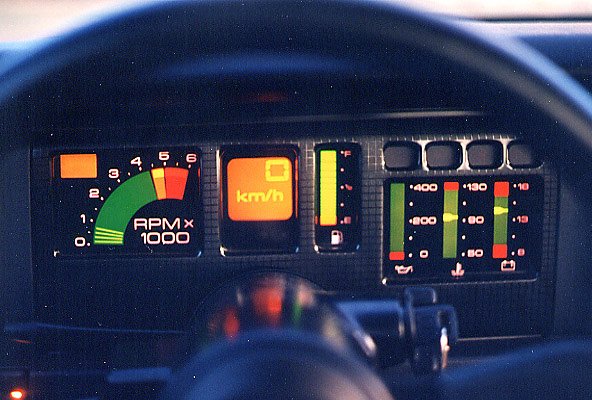
Here's the main view from behind the wheel. In the extreme left "pod" we have the tachometer (with its
5000 RPM redline, although my 305 seems to be capable of revving up to 5300-5500 quite nicely).
The little orange-ish square in the top left corner of that "pod" is the inactive upshift indicator,
inactive because the car is an automatic. Goose the throttle and watch the RPM display climb as
the engine revs happily past the yellow range and into the red.

The next mini-pod is the speedo/turn-signal/hi-beam cluster. The speedo can read in 1 kph increments
from about 3 kph upwards. Unfortunately, the third digit is a hard-coded "1", meaning that while in
Metric mode, the highest it will indicate is 199 kph. At this point, switching to Imperial (ie. MPH)
mode will allow you to read higher speeds, which it is quite capable of.
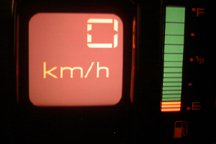
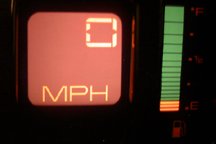

Next mini-pod, the fuel guage. Once you're down to 1 orange bar left, a VERY loud beep will indicate
an urgent need for a fillup.
The next pod indicates, in left-to-right order, oil pressure, coolant temperature, and voltage.
Being a Canadian car, this particular display was forced to metric (see the white numerals).
The oil pressure reads in kilopascals and the coolant temperature reads in degrees Celsius.
Notable in this picture is the pretty decent oil pressure reading. I can't complain...
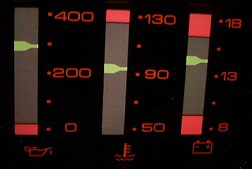
Above the right most pod is a set of idiot lights which I would prefer not to see at all (ie. Brake,
SES, seatbelt, Choke - this last one is probably a remnant of all those LG4 4-barrel equipped T/As
from 1982-1987).
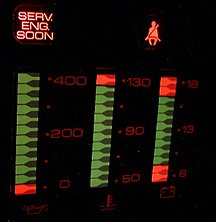
Wait, there's more! To the right of all this we find the Driver Information Center (DIC), located just before we reach the end of the instrument panel (and driver's side of the dash). At the extreme end of this panel are the twin outlets for the climate control system, which are situated in the exact
location where they would be found on an analog instrument panel. All this sits above the climate control buttons and the factory GM Delco radio.
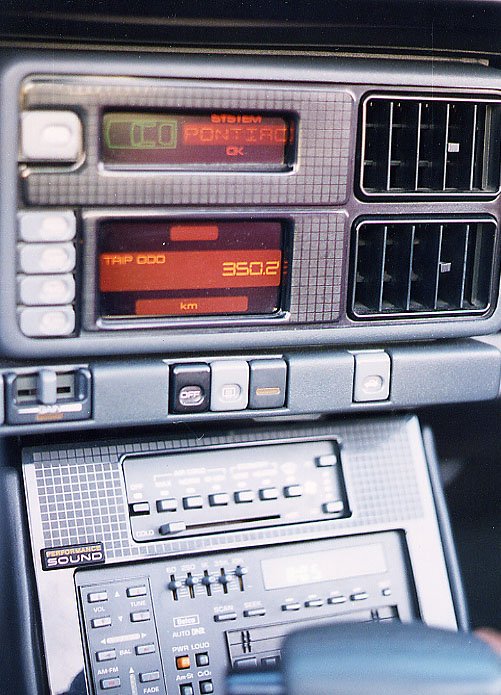
The Driver Information Center... What
in the world was Pontiac thinking when they named that little information readout? You can imagine
all the jokes associated with an acronym like "DIC". It is a pretty functional little monitor, though. It provides a
monitor of all doors, rear hatch, coolant and washer levels, and headlamp/parking-lamp/tail-lamp condition. If anything is amiss, a small graphic will appear on the outline of the car in the area of the anomaly, and the appropriate text will scroll onto the little screen. Here's a couple of examples of this monitor in action (these were all output as part of the self-test... had there
been an actual fault scenario, the "system OK" letters would not have been lit):
 ----> Everything is normal.
----> Everything is normal.
 ----> Left door is ajar.
----> Left door is ajar.
 ----> Rear hatch is open.
----> Rear hatch is open.
 ----> A front lamp is burnt out.
----> A front lamp is burnt out.
The lower pod of the DIC provides several bits of information. It can display the car's total mileage, the trip odometer, or an average speed indication (which I have never found to be of any particular
use). The buttons alongside the display allow for the toggling of all this information, along with providing the toggle for Metric/Imperial measurements. The topmost button is the DIC self-test, as
referenced above.
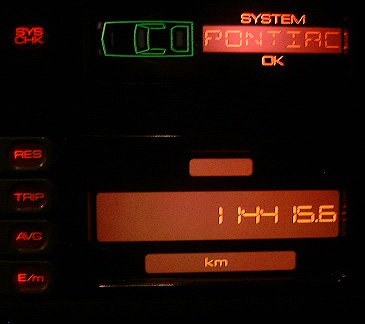
The three controls immediately below are the subwoofer gain slider, rear defroster, and hatch release. The subwoofer option was a little-known option available with the top-of-the-line sound system for Firebirds in the mid 80's, and is discussed elsewhere. Suffice for the moment to specify
that the slider controlled the gain on the separate power amplifier located under the
passenger's side of the dash, near the ECM.

Another option that was usually found in cars equipped with the digital dash
was the electronic climate controls. The sliders and knobs of the standard
climate control unit were replaced with buttons. Below that is the top radio
for Firebirds in 1987... a completely push-button-controlled radio and cassette
unit. The 'Performance Sound' emblem denoted the presence of the subwoofer option, I believe.










 ----> Everything is normal.
----> Everything is normal.
 ----> Left door is ajar.
----> Left door is ajar.
 ----> Rear hatch is open.
----> Rear hatch is open.
 ----> A front lamp is burnt out.
----> A front lamp is burnt out.


